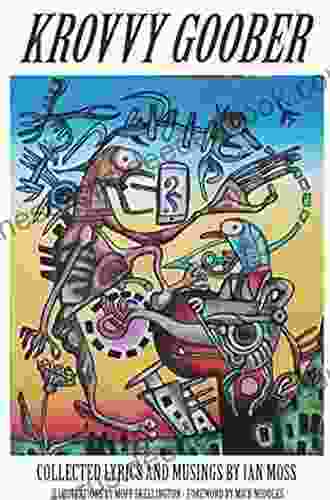The Social Construction of Native American Criminality

4.4 out of 5
| Language | : | English |
| File size | : | 2381 KB |
| Text-to-Speech | : | Enabled |
| Screen Reader | : | Supported |
| Enhanced typesetting | : | Enabled |
| Word Wise | : | Enabled |
| Print length | : | 327 pages |
| Lending | : | Enabled |
| Paperback | : | 120 pages |
| Item Weight | : | 1.55 pounds |
| Dimensions | : | 6.14 x 0.94 x 9.21 inches |
| Hardcover | : | 402 pages |
Native Americans are overrepresented in the criminal justice system, both as victims and offenders. This overrepresentation is not due to any inherent criminality of Native Americans, but rather to the social construction of Native American criminality.
The social construction of Native American criminality is a process that has been going on for centuries. It began with the colonization of the Americas by Europeans, who brought with them their own ideas about crime and punishment. These ideas were based on the belief that Native Americans were inferior and uncivilized, and that they needed to be controlled through the use of force.
The social construction of Native American criminality has continued in the years since colonization. In the 19th century, the United States government implemented a series of policies that were designed to assimilate Native Americans into white society. These policies included the forced removal of Native Americans from their traditional lands, the suppression of their languages and cultures, and the establishment of Indian boarding schools. These policies had a devastating impact on Native American communities, and they contributed to the overrepresentation of Native Americans in the criminal justice system.
In the 20th century, the social construction of Native American criminality continued through the media. Native Americans were often portrayed as criminals in movies, television shows, and newspapers. This portrayal reinforced the stereotype of Native Americans as being violent and dangerous, and it contributed to the public's perception of Native Americans as a threat.
The social construction of Native American criminality has had a number of negative consequences. It has led to the overrepresentation of Native Americans in the criminal justice system, and it has contributed to the discrimination and violence that Native Americans face in society. It has also made it difficult for Native Americans to get jobs, housing, and education.
The social construction of Native American criminality is a complex issue, but it is one that needs to be addressed. By understanding the historical and contemporary factors that have contributed to this overrepresentation, we can begin to work towards creating a more just and equitable society for Native Americans.
Historical Factors
The social construction of Native American criminality began with the colonization of the Americas by Europeans. Europeans brought with them their own ideas about crime and punishment, which were based on the belief that Native Americans were inferior and uncivilized. This belief was reinforced by the fact that Native Americans often resisted European colonization, and they were often portrayed as being violent and dangerous.
In the 19th century, the United States government implemented a series of policies that were designed to assimilate Native Americans into white society. These policies included the forced removal of Native Americans from their traditional lands, the suppression of their languages and cultures, and the establishment of Indian boarding schools. These policies had a devastating impact on Native American communities, and they contributed to the overrepresentation of Native Americans in the criminal justice system.
The forced removal of Native Americans from their traditional lands was particularly disruptive. It led to the loss of land, resources, and cultural identity. It also led to increased poverty and unemployment, which are both risk factors for crime.
The suppression of Native American languages and cultures also had a negative impact. It made it difficult for Native Americans to communicate with each other and to pass on their traditions to their children. It also contributed to the loss of cultural identity, which can lead to feelings of alienation and anomie.
Indian boarding schools were another factor that contributed to the overrepresentation of Native Americans in the criminal justice system. These schools were designed to assimilate Native American children into white society. However, they often used harsh methods, such as corporal punishment and cultural suppression. This led to resentment and anger among Native American students, and it increased the likelihood that they would turn to crime as a way of expressing their frustration.
Contemporary Factors
The social construction of Native American criminality continues in the present day. Native Americans are still overrepresented in the criminal justice system, and they continue to face discrimination and violence in society. There are a number of contemporary factors that contribute to this problem.
One of the most significant contemporary factors is poverty. Native Americans are more likely to live in poverty than any other racial or ethnic group in the United States. Poverty is a major risk factor for crime, and it can lead to a number of problems that can contribute to criminal behavior, such as lack of education, unemployment, and poor housing.
Another contemporary factor that contributes to the social construction of Native American criminality is discrimination. Native Americans face discrimination in many areas of life, including employment, housing, and education. This discrimination can lead to feelings of anger and resentment, which can increase the likelihood that Native Americans will turn to crime as a way of expressing their frustration.
Violence is another major problem that Native Americans face. Native Americans are more likely to be victims of violence than any other racial or ethnic group in the United States. This violence can come from a variety of sources, including police brutality, hate crimes, and domestic violence. Violence can lead to physical and psychological trauma, which can increase the likelihood that Native Americans will turn to crime as a way of coping.
The social construction of Native American criminality is a complex issue that has been going on for centuries. It is the result of a number of historical and contemporary factors, including poverty, discrimination, and violence. These factors have led to the overrepresentation of Native Americans in the criminal justice system, and they continue to contribute to the problems that Native Americans face in society.
It is important to understand the social construction of Native American criminality in order to begin to address it. By working to reduce poverty, discrimination, and violence, we can help to create a more just and equitable society for Native Americans.
4.4 out of 5
| Language | : | English |
| File size | : | 2381 KB |
| Text-to-Speech | : | Enabled |
| Screen Reader | : | Supported |
| Enhanced typesetting | : | Enabled |
| Word Wise | : | Enabled |
| Print length | : | 327 pages |
| Lending | : | Enabled |
| Paperback | : | 120 pages |
| Item Weight | : | 1.55 pounds |
| Dimensions | : | 6.14 x 0.94 x 9.21 inches |
| Hardcover | : | 402 pages |
Do you want to contribute by writing guest posts on this blog?
Please contact us and send us a resume of previous articles that you have written.
 Novel
Novel Chapter
Chapter Text
Text Genre
Genre Library
Library Paperback
Paperback E-book
E-book Magazine
Magazine Paragraph
Paragraph Bookmark
Bookmark Preface
Preface Synopsis
Synopsis Annotation
Annotation Manuscript
Manuscript Codex
Codex Tome
Tome Bestseller
Bestseller Classics
Classics Encyclopedia
Encyclopedia Dictionary
Dictionary Narrator
Narrator Character
Character Resolution
Resolution Catalog
Catalog Card Catalog
Card Catalog Stacks
Stacks Archives
Archives Study
Study Research
Research Scholarly
Scholarly Lending
Lending Reserve
Reserve Reading Room
Reading Room Rare Books
Rare Books Interlibrary
Interlibrary Study Group
Study Group Dissertation
Dissertation Storytelling
Storytelling Book Club
Book Club Textbooks
Textbooks Eric Kent Edstrom
Eric Kent Edstrom Patricia Strange
Patricia Strange Janet Majerus
Janet Majerus Dixie Dawn Miller Goode
Dixie Dawn Miller Goode Cynthia Cruz
Cynthia Cruz Sara Fields
Sara Fields Joseph Roisman
Joseph Roisman Sara Richardson
Sara Richardson Cgp Books
Cgp Books Robert J Werner
Robert J Werner Alex Frankel
Alex Frankel Sharon Barnes
Sharon Barnes David Walter
David Walter Nc Marshall
Nc Marshall June Mccrary Jacobs
June Mccrary Jacobs Erik Varden
Erik Varden Tommy Woodard
Tommy Woodard Whitney L Grady
Whitney L Grady Marie Sontag
Marie Sontag Deanna Chase
Deanna Chase
Light bulbAdvertise smarter! Our strategic ad space ensures maximum exposure. Reserve your spot today!

 Allen GinsbergStevie Ray Vaughan Masterclasses: Unlocking the Secrets of Legendary Blues...
Allen GinsbergStevie Ray Vaughan Masterclasses: Unlocking the Secrets of Legendary Blues...
 Anton FosterUnveiling the Literary Legacy of the Edda: A Comprehensive Exploration of The...
Anton FosterUnveiling the Literary Legacy of the Edda: A Comprehensive Exploration of The... Austin FordFollow ·19.8k
Austin FordFollow ·19.8k Kenneth ParkerFollow ·14.7k
Kenneth ParkerFollow ·14.7k Hunter MitchellFollow ·11.3k
Hunter MitchellFollow ·11.3k Stephen FosterFollow ·13.2k
Stephen FosterFollow ·13.2k Bret MitchellFollow ·8.2k
Bret MitchellFollow ·8.2k Christian BarnesFollow ·19.9k
Christian BarnesFollow ·19.9k Blake BellFollow ·18.2k
Blake BellFollow ·18.2k Maurice ParkerFollow ·9.2k
Maurice ParkerFollow ·9.2k

 Gary Reed
Gary ReedWeb to Web for Beginners: A Comprehensive Guide to...
In today's interconnected world, websites...

 Elliott Carter
Elliott CarterThe Moon Is Down: John Steinbeck's Poignant Portrait of...
In the annals of literature, John...

 Dalton Foster
Dalton FosterMark The Mechanic: The Incredible Story Of A Young...
In the vibrant realm of robotics, where...

 Fred Foster
Fred FosteriPhone 13 Pro Max User Guide: Everything You Need to Know
The iPhone 13 Pro Max...

 Rodney Parker
Rodney ParkerPope John Paul II: The Pocket Giant Who Inspired Millions
Pope John Paul II, or...
4.4 out of 5
| Language | : | English |
| File size | : | 2381 KB |
| Text-to-Speech | : | Enabled |
| Screen Reader | : | Supported |
| Enhanced typesetting | : | Enabled |
| Word Wise | : | Enabled |
| Print length | : | 327 pages |
| Lending | : | Enabled |
| Paperback | : | 120 pages |
| Item Weight | : | 1.55 pounds |
| Dimensions | : | 6.14 x 0.94 x 9.21 inches |
| Hardcover | : | 402 pages |








